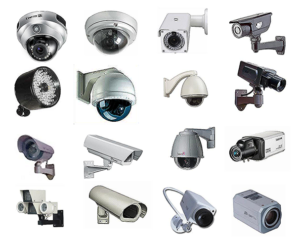
There are a wide range of different commercial and home security cameras out there, each with their own specific strengths and weaknesses—different cameras are better for different uses. Part of your home security system isn’t only deciding to install a camera, but selecting the right camera to protect you. Here are some of the most common types, and some of their pros and cons.
A box style security camera is probably the first thing you think of when you picture a security camera. Connected to the center DVR, they are mounted in a plain, square housing. They’re mainly used in commercial or industrial premises, where aesthetics are not a major concern. Because they are in a housing, they are ideal for outdoor use, where the camera is exposed to the elements and weather. They offer a lot of customization options, in regards to the lens, camera and housing, to meet your precise needs—they are very versatile, if not particularly aesthetically pleasing.
If you’re more concerned about aesthetics, a dome camera might be better for you. Coming in a dome-shaped housing, they provide a clear visual cue that an area is under surveillance, but aren’t as obtrusive as the classic box style. Dome cameras are very difficult to destroy or tamper, and can come with a wide variety of features and options.
Other types include turret cameras. A subset of dome cameras, turrets can tilt and revolve, allowing you to adjust their field of focus without removing and reinstalling the dome. Eyeball cameras fall into this same category – a type of dome camera that can be rotated and moved to cover more ground far more easily than a traditional dome camera.
You can also get discreet cameras—sometimes known as “spy” cameras—but they come with a set of issues and concerns. Their main benefit is that, once installed, they cannot be seen, allowing you to film people without knowing they are being filmed. There are both practical concerns with these cameras, in terms of picture quality and deterrence, as well as potential legal concerns with filming someone without their knowledge, however, so in most cases, you’ll want to opt for a more visible camera. Because of these legal issues, especially with the recording of audio, video/audio cameras should not be installed for outdoor use.
A PTZ camera stands for “pan, tilt and zoom”—there are controls where you can remotely pan, tilt and zoom the camera, allowing you to focus on areas of interest, track movement, and cover a wide area with a single camera. You can also set up a program to have them automatically sweep the area without your control. They can be bulkier than other types of camera, but they’re great if you’re trying to secure a large store or a warehouse area, as you can cover more ground with fewer cameras. In the harsh Canadian elements, you need top-quality cameras to last. With the number of moving parts PTZ cameras have, they can be vulnerable. Cheap cameras will not last very long – you really get what you pay for, here.
Storage is another area where you have multiple options. Some cameras store locally, in the camera itself. They typically have a microSD card slot, that can hold anywhere from 16 to 128 gigabytes of information. Other cameras save information to the DVR itself, saving the footage locally on your system. When your memory fills up – which will take different amounts of time based on quality of footage and duration of coverage – you can either overwrite previous footage or manually manage your space. The video is readily accessible, without having to connect to an outside system or pay any sorts of fees.
Other systems use cloud storage. Your footage is sent off to a remote server, where it is stored and accessed. These will often come with a monthly fee of some sort to save your footage, and in return, you avoid the hassle of dealing with a microSD card or otherwise manually managing your space; that’s all taken care of for you. Local storage offers more control; cloud storage offers more convenience. It’s really a matter of preference which you prefer.
Of course, most of these cameras can come with a wide variety of options, as well. Most models of cameras have high-definition options, which provide clearer pictures in return for a slightly higher cost and more storage space. Some cameras can include infrared or night-vision options, allowing you to see images in pitch-black conditions. Some cameras can transmit wirelessly, usually over WiFi, allowing you to hook them up without complicated wiring, at the expense of the stability and security you get out of a fully integrated wired system. Depending on precisely what your needs are, you should have a wide variety of options to choose from.
Do you want to protect your business or home, but don't know how to get started? We can help. Call (416) 697-7329 and talk to a security specialist. Our experts can give insight into your alarm monitoring needs.
Contact us today at (416) 697-7329
let us help you ensure the continued safety of your business.